Proper air preparation significantly increases the process and production reliability of machines. Particles, water and oils in compressed air reduce the service life and functionality of components and systems. They also impair productivity and energy efficiency. In this article, a variety of air filtration and air treatment products are outlined and discussed, along with ancillary equipment like drains. Additionally, the article provides an overview of the compressed air purity classes defined by ISO 8573-1:2010.
Why Compressed Air Filtration is Necessary
One cubic foot of compressed air can contain millions of dirt particles, considerable amounts of water and oil — and even heavy metals like lead, cadmium and mercury. If they are not filtered out, trouble-free operation of the system components, like valves and cylinders, cannot be guaranteed in the long term. Poorly prepared compressed air can contaminate control valves, and cause seals to swell and wear prematurely. As a result, the right compressed air preparation is essential for reducing machine downtime, and for reducing maintenance and energy costs.
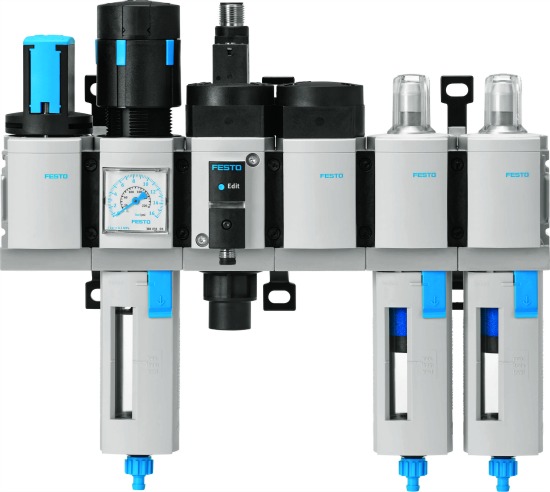
Air preparation filters from FESTO help eliminate compressed air contaminants, like dirt, water and oil.
The Variables of Compressed Air Preparation
There are three variables to air preparation: compressed air purity, compressed air quantity (flow) and compressed air pressure. Depending on the system requirements, coordinating these three variables ensures high compressed air quality, and forms the basis for selecting the proper service unit components. The required compressed air purity increases both the running performance and the efficiency of pneumatic systems, and can ensure compliance with legal specifications in industries such as food processing. The flow quantity is largely determined by flow cross sections and the design dimensions of the machine. In general and provided the design is the same, larger components have higher flow rates. Optimized operating pressure increases the efficiency, minimizes wear and reduces power consumption. In order to coordinate the compressed air purity, compressed air quantity and pressure for the specifications of a system, the correct individual components must be selected. For example, this includes on/off valves, pressure build-up valves, pressure regulators, water separators, filters and drying units.
Types of Filters and Air Treatment Equipment
There are different types of air treatment components for removing contaminants, such as solid particles, liquid water, water vapor and oil vapors, odorants, and even bacteria and viruses. For most automation applications, the focus is to remove solid particles and water.
Water Separators remove condensate, either with a centrifugal design or a coalescing principle.
- A centrifugal separator (Figure 1) causes a rotary motion in the air, forcing particles to accelerate in a radial outward movement. Once they reach the outside, they drain into the bowl. These are effective for removing water droplets, as well as dust and dirt particles larger than 5 microns in size. No maintenance is required for this process.
- A coalescing separator flows the air from the inside to the outside of the filter element. These filter cartridges must be replaced regularly.
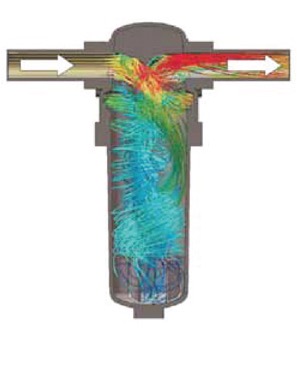
Figure 1: Centrifugal water separators remove condensate from compressed air by accelerating particles in a radial motion.
Filters are used to remove particles, condensate and oil.
- Coarse / particulate filters (Figure 3) have a pore size of 5 to 40 microns. The air flows past a centrifugal separator and then through the filter element. The filter elements are often a sintered material, like polyethylene or bronze.
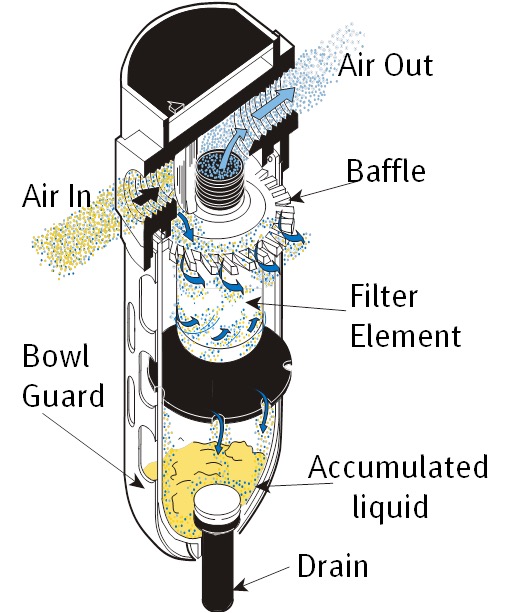
Figure 2: Course filters remove larger sized particles, condensate and oil, and protect finer filters downstream.
- Fine and micro filters remove particles smaller than 1 micron, down to 0.01 micron. The air flows through the filter cartridges from the inside to the outside. Solid particles get stuck in the filter cartridge, clogging it up. Fluid particles, such as condensate or oil, coalesce or attach to larger droplets, which flow off and are caught in the filter bowl. It is important to cascade your filters to avoid prematurely clogging the filter element. For example, if 1-micron filtration is needed, it is recommended to use a 5-micron filter upstream so that the 1-micron filter does not become clogged with larger particles.
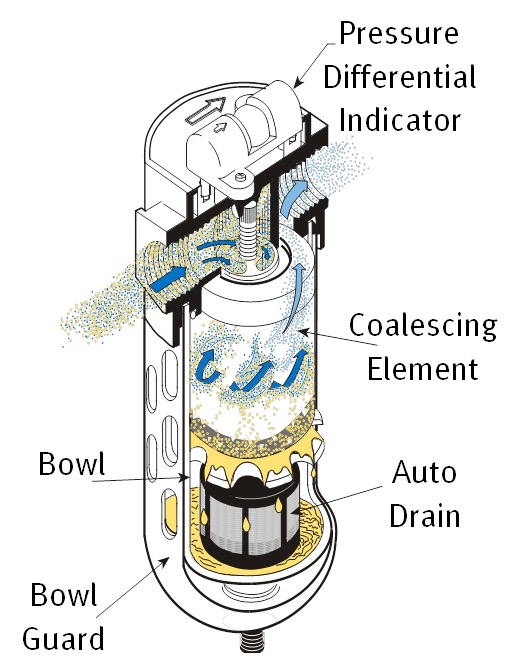
Figure 3: Coalescing filters remove sub-micronic particles, including condensate and oil, which flow off and collect in the filter bowl.
- Activated carbon filters bond hydrocarbon residue, odorants and oil vapors.
- Sterile filters ensure that the air is free of germs.
Dryers are used to remove water vapors beyond the capability of the fine and micro coalescing filters, and are classified according to the pressure dew point (PDP) that can be achieved. The pressure dew point defines the temperature to which compressed air can be cooled without making the water in it condense. If the temperature is below the pressure dew point, condensate will form. Even if the temperature is subsequently increased, this condensate will remain and can lead to corrosion of components.
- Refrigeration dryers are commonly located downstream from the plant’s air compressor. The air is cooled to just above freezing in a cooling unit, and the condensate that falls off is drained away. The pressure dew point achieved is around 37°F (3°C). To avoid condensation, it is recommended that the pressure dew point is set to 50°F (10°C) below the ambient temperature, so a refrigeration dryer is sufficient for systems whose operating temperature never drops below 55°F (13°C).
- Membrane dryers supress the pressure dew point in relation to inlet conditions. The air flows longitudinally through a bundle of parallel, hollow fibers. During this process, water vapor diffuses because of a partial pressure drop from the inside of the fibers to the outside. The vapor is exhausted out using purge air. Due to the purge air, the maintenance-free membrane dryer has a certain amount of constant bleed/air consumption.
- Adsorption dryers are used when pressure dew points of -40°F (-40°C) to -94°F (-70°C) are required. The dryers use molecular forces to bond gas or vapor molecules to a drying agent, such as desiccant beads. Since the drying agent is regenerative, two chambers are required. While drying takes place in one, the drying agent in the other has time for cold or warm regeneration. In devices with cold regeneration, some of the dried air is used to dry the adhesion agent. When warm regeneration is used, the water evaporates as heat is applied. The drying agent must be replaced periodically (i.e., after 8,000 hours of service).
Common Desiccant Compressed Air Dryer Sizing Errors - Webinar RecordingDownload the slides and watch the recording of the FREE webcast to learn:
|
Types of Drains for Filter Units
There are a few different types of drains available for filter units:
- Manual: Condensate is drained manually by twisting the drain plug. These require a regular maintenance schedule (i.e., once per shift).
- Semi-automatic/normally open: This type of drain opens as soon as the compressed air is shut off.
- Fully automatic/normally open: This type of drain opens as soon as the compressed air is shut off, or a specified level is reached in the bowl.
- Fully automatic/normally closed: These filters open as soon as the compressed air is switched on and a specified level is reached in the bowl.
- Electric drains are also available, which can be opened/closed remotely with an electrical signal.
Properly Maintaining Filter Elements
To maintain efficient operation of filters, the filter elements need to be replaced periodically. How often this needs to be done depends on variables like the quality of the supply air and the hours of operation of the machine. As one approach, you can identify and set a preventive maintenance schedule that replaces the filter elements every 6 months.
A more reliable method is to use differential pressure sensors, which measure the pressure drop between a filter’s supply and output pressure. The pressure drop indicates when the filter is becoming clogged. These can be electrical sensors that send a signal to a PLC, which can then alert the operator, or they can be visual indicators on the filter unit itself. For example, the indicator might show a green color when the filter element is clean, and a red color when the filter element is clogging up and needs to be replaced.
Compressed Air Purification & Piping Monthly e-NewsletterWith a focus on Demand-Side Optimization, compressed air dryers, filters, condensate management, tanks, piping and pneumatic technologies are profiled. How to ensure system reliability, while reducing pressure drop and demand, is explored through System Assessment case studies. |
Defining Compressed Air Purity Levels with ISO 8573-1:2010
To help everyone communicate in the same language regarding air quality, international standard ISO 8573 was established in 2010 with definitions for compressed air quality. The air quality is defined with class ratings for three types of contaminants: solid particles, water condensate content, and oil content. The classes range from 1 through 9, and X, with the lower numbers representing higher air purity. It specifies the maximum permissible levels of contamination and particle sizes for the respective quality classes. The air quality class will help you identify what type of compressed air treatment products are needed.
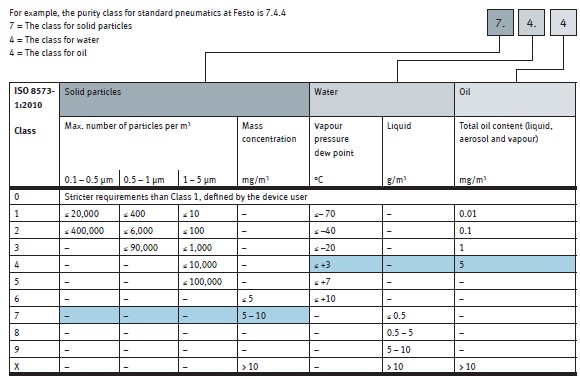
ISO 8573-1:2010 helps everyone communicate in the same language about compressed air quality.
For more information, contact Mike Guelker, tel: (631) 609-3721, email: michael.guelker@festo.com.
To read more about Compressed Air Treatment, please visit www.airbestpractices.com/technology/air-treatment.




